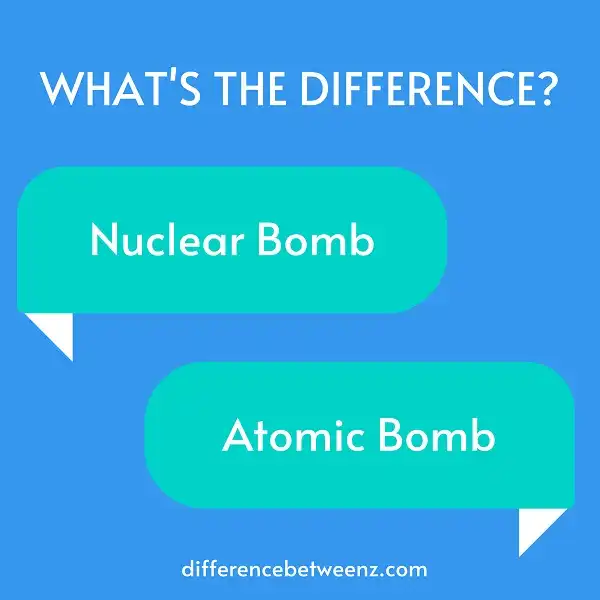The distinction between atomic and nuclear, while often used interchangeably in colloquial discussions, pertains to fundamentally different aspects of matter and energy in the realm of physics. This article endeavors to elucidate these differences, addressing a common observation that arises from the terminology used in scientific discourse while revealing the deeper complexities underlying these concepts. It is essential to navigate the lexical nuances to foster a more profound understanding of atomic and nuclear phenomena.
To commence, the term “atomic” is derived from the Greek word “atomos,” meaning indivisible. In contemporary physics, it primarily refers to the smallest unit of an element that retains the chemical properties of that element. An atom comprises a nucleus, which contains protons and neutrons, surrounded by electrons that occupy various energy levels or orbitals. The behavior and interactions of atoms underpin the principles of chemistry and material science.
Conversely, “nuclear” pertains specifically to the nucleus of an atom. The nucleus serves as the core of the atom, composed of positively charged protons and uncharged neutrons, collectively referred to as nucleons. The interactions and forces at play within the nucleus are described by the principles of nuclear physics. This specialized field delves into phenomena such as nuclear decay, fission, and fusion, which are crucial in understanding the energy release mechanisms that occur within atomic nuclei.
One of the primary divergences between atomic and nuclear concepts lies in their respective energies. Atomic energy is often associated with chemical reactions where atoms form or break bonds with one another. The energy changes involved in these processes are relatively modest compared to the energies released in nuclear reactions, where mass-energy equivalence, as posited by Einstein’s theory, comes into play. The equation (E=mc^2) illustrates that a small amount of mass can be converted into a significant amount of energy during nuclear transformations, resulting in explosive outcomes, as evident in nuclear weapons or energy generation in reactors.
It is also crucial to delineate the types of forces involved. Atomic interactions are primarily governed by electromagnetic forces—the attraction between the negatively charged electrons and the positively charged nucleus. These forces dictate the structure and stability of atoms, influencing chemical reactivity and bonding behavior. In stark contrast, the forces that bind nucleons together in the nucleus are governed by the strong nuclear force, a fundamental interaction that operates at exceedingly short ranges but is immensely powerful, overcoming the repulsive electromagnetic forces between protons within the confined space of the nucleus.
The terminology that surrounds atomic and nuclear processes evokes a sense of fascination owing to the potency and implications of these mechanisms. Atomic theory laid the groundwork for modern chemistry and materials science, enabling advancements in various technological fields including electronics and pharmaceuticals. Meanwhile, nuclear physics has paved the path toward harnessing vast amounts of energy, leading to both the development of nuclear reactors for electricity generation and the proliferation of nuclear weapons, posing profound ethical and existential dilemmas.
One of the compelling contrasts is the societal perception and acceptance of nuclear vs. atomic technologies. The peaceful applications of atomic principles are celebrated in myriad innovations, from medical imaging to energy-efficient materials. However, the catastrophic potential of nuclear weapons often engenders fear and wariness. The historical context of nuclear warfare highlights the duality of these scientific advances—while they can save lives or contribute to sustainable energy, they also possess the capacity for unparalleled destruction.
The romantic allure of atomic energy is frequently encapsulated in the advancements of modern physics. The exploration of atomic structure and the behavior of electrons have given rise to the revolutionary field of quantum mechanics. This domain elucidates the probabilistic nature of atomic particles and fundamentally challenges classical notions of determinism. The strange behaviors, such as superposition and entanglement, invite deeper intrigue and illuminate phantasmagorical realities that exist beneath the surface of our tangible experience.
On a broader scale, the intersection of atomic and nuclear science touches on existential questions about the fabric of the universe and the origins of matter itself. From the Big Bang to the formation of elements in stars through nuclear fusion, understanding atomic and nuclear properties grants insights into cosmic evolution. These inquiries resonate with humanity’s enduring quest for knowledge and the inherent desire to fathom our place in the universe.
As one ventures deeper into the realms of atomic and nuclear science, various applications thus emerge, highlighting their intertwined yet distinct natures. The medical domain exemplifies this, where atomic radiation is harnessed in radiation therapy for cancer treatment, yet the nuclear chemistry principles are employed to develop radiopharmaceuticals. This convergence illustrates the multifaceted implications of both domains, emphasizing the importance of nuanced understanding in policy-making and technological advancement.
In conclusion, while “atomic” and “nuclear” may seem similar on the surface, their implications and domains are uniquely distinct. Grasping the subtleties between these concepts opens pathways to engage with modern scientific and philosophical discourses. As societies navigate the complexities of scientific advancements, a profound comprehension of atomic and nuclear principles becomes essential—framing the dialogue around responsible innovation and ethical considerations in an era characterized by rapid technological change. This understanding is not merely rooted in academic pursuit; it resonates within the broader narrative of human civilization and its aspirations, illuminating the path ahead.












